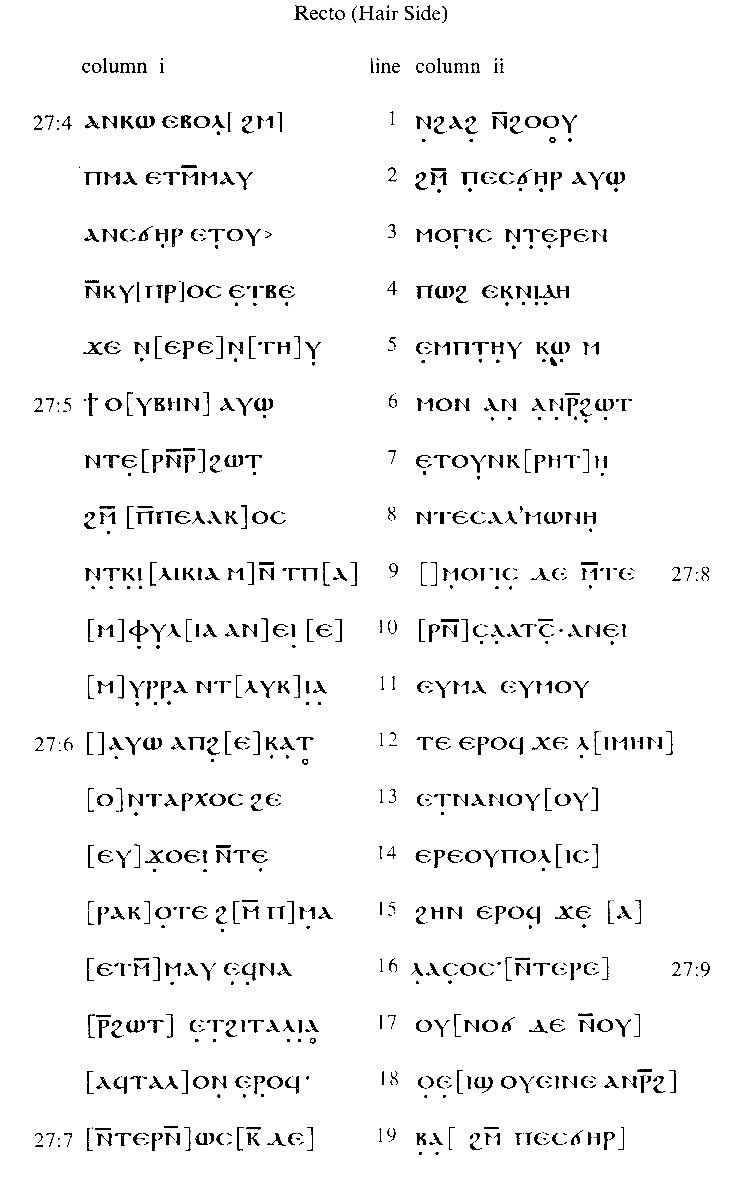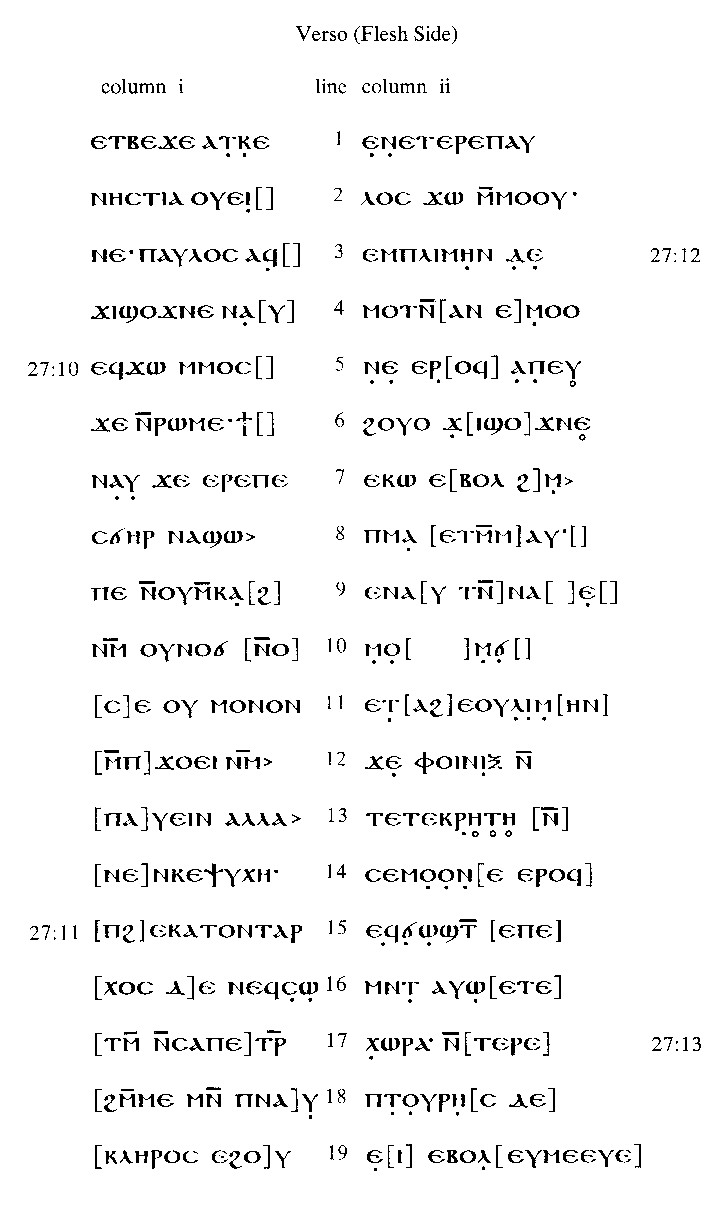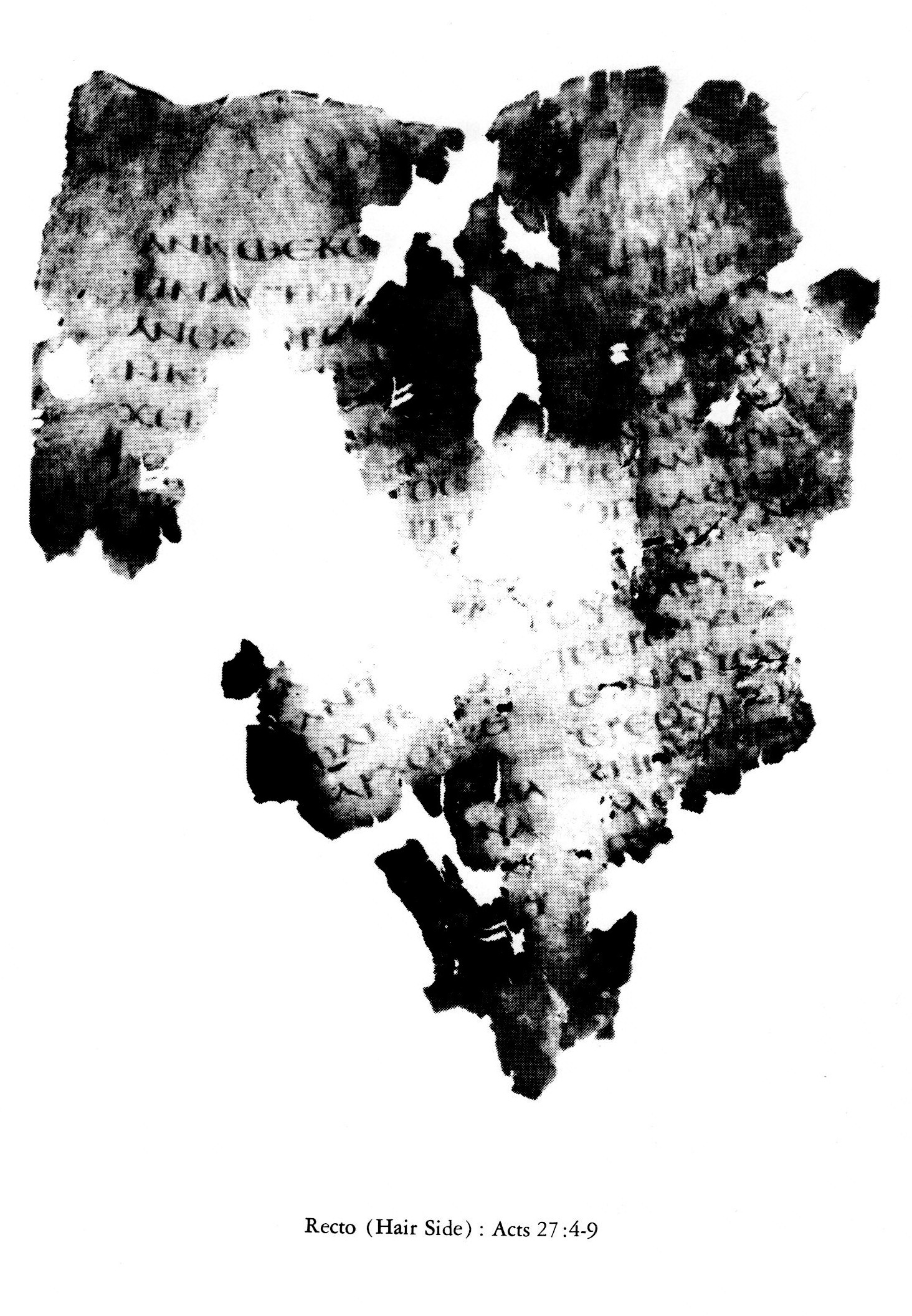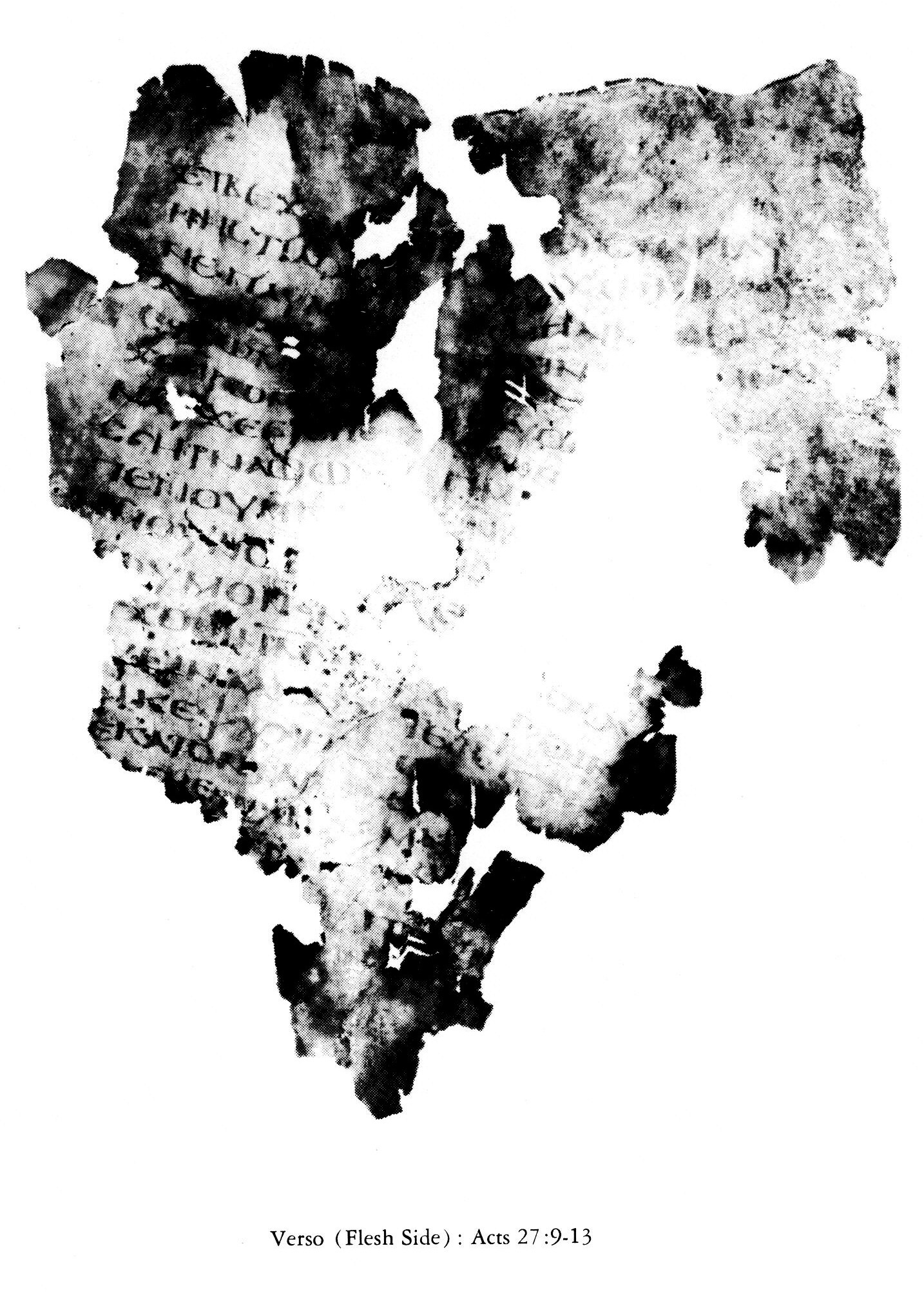A SAHIDIC PARCHMENT FRAGMENT OF ACTS 27.4-13
AT THE UNIVERSITY MUSEUM, PHILADELPHIA
(E 16690 Coptic
1)
ROBERT A. KPAFT
UNIVERSITY OF
PENNSYLVANIA, PHILADELPHIA, PA 19104
(in
consultation with James M. Robinson) \*/
\*/
This article appeared originally in the Journal of Biblical Literarure
94 (1975), 256-265 plus plates of both recto and verso. It has received
minor editorial adjustments in its electronic form, which was initially
scanned and proofed by Laura Ng (July 2006).
The following parchment/vellum fragment of Acts in Sahidic was rescued from a neglected box of unflattened papyri in the basement of the University Museum at the University of Pennsylvania in Philadelphia.\1/ It is part of a heterogeneous mass of inscribed materials (mostly papyrus, but some leather and paper), in various languages (especially Greek, Coptic, and Arabic), that came into the possession of the Museum through W. Max Müller in the year 1910, possibly acquired by him from a dealer in Cairo.\2/ Over the years, much of this material has remained virtually in the same condition as it was when it arrived - unflattened and thus unavailable for examination by interested specialists - until R. A. Kraft requested and received permission to begin to humidify and flatten the numerous fragments in 1966.
\1/ This material is published with the
kind permission of the University Museum and the associate curator of
its Egyptian section, David O'Connor. The generous advice and
assistance provided by John Turner at various stages of the preparation
of this article for publication is also gratefully acknowledged.
\2/ For
biographical information about Müller (1862-1919), see the Dictionary
of American Biography 13 (1934) 320-21. The trip to
Egypt in 1910 was Müller's third and last expedition for the Carnegie
Institution of Washington, DC; he spent most of that summer at the
island of Philae in the upper Nile, but had long since established
strong contacts at Cairo and Thebes. See the three volumes of his
Egyptological Researches (Washington: Carnegie Institution,
1906-1920). Further details on the history of the collection of
papyri at the University Museum have been compiled by Patricia L. Crown
as part of a project to preserve and catalogue the materials under the
direction of R. A. Kraft. [Crown's work was further developed by John
R. Abercrombie in his "A HISTORY OF
THE ACQUISITION OF PAPYRI AND RELATED WRITTEN MATERIAL IN THE
UNIVERSITY (OF PENNSYLVANIA) MUSEUM" (1980) as well as in his
earlier article on "The University Museum's collection of
Papyri and related Materials"
(1978).]
One of the boxes (numbered E 16690) contained, among hundreds of other pieces, a parchment scrap that had shrivelled up like a closed fist so that it was holding several papyri in its brittle clutch, After humidification, the parchment was carefully separated from the papyri for preliminary flattening, and was seen to be part of a neatly written Coptic codex containing references to "Paul." [[257]] A rough transcription was prepared and was distributed privately to a few scholars known to be engaged in Coptic studies, but so little of the transcription could be read with confidence that the fragment was not identified immediately. Meanwhile, the work of flattening the other Museum materials continued as time permitted. Then in the summer of 1968, James M. Robinson examined the transcription and was successful in identifying it as part of the account in Acts 27. This led to a fresh attempt at flattening and reading the poorly preserved fragment, which was now relatively easy to reconstruct on the basis of continuous text provided by the other preserved MSS of Acts in Sahidic (see below).
The text of this fragment is written in very neat Coptic letters of the "biblical uncial" type,\4/ with two columns per page and approximately 9-11 letters per line, 19 lines per column. The original codex was in "petit format," with its pages at least 15 cm. tall and 12 cm. wide, and margins of 2 cm. at the top, 1.5 cm. on the inside, and 1 cm. between the columns (each of which was 4 cm. wide); the outer margin was at least 1 cm. wide, but is especially badly preserved, as is the lower margin.\4a/
\4/ See
C. H. Roberts, Greek Literary Hands
330 B.C.-A.D. 400 (Oxford: Clarendon, 1955; 2d
ed., 1956), for a characterization of the Greek "biblical uncial"
(regularity of size and shape, use of thick and thin strokes) and for
some early examples (pls. 16a, 22b, 24b). Examples of early
Coptic "Bibelstil" (4th through 6th centuries) are presented in V.
Stegemann, Koptische Paläographie
(Quellen und Studien zur Geschichte und Kultur des Altertums und
des Mittelalters, 1; Heidelberg: Bilabel [privately], 1936), esp. pls.
2-5 and 8-9.
\4a/ [[add note to Turner, Codex]]
The
leather was of fine quality but is now badly shrunken and torn in
spots, as well as discolored by deterioration. The first portion
of preserved text is written on the more polished, hair side of the
parchment; the reverse is on the paler, flesh side. No traces are
evident of how the lines were ruled in preparing the codex. The
writing is in pale brown ink, with letters approximately 2.5 mm. tall,
and closely resembles other biblical MSS from the 4th to 7th centuries, including the "great Greek
uncials" like B, S (Aleph), A, C, G, and Θ (Washington MS 1). It is tempting to date the fragment towards the earlier
part of that period -- perhaps in the 5th century, or even the 4th.\5/ The forms of the special
Coptic letters seem to suggest a relatively early date, and this is
supported by the fact that the letters a and m are not in the "Coptic style"
that came to be used widely in the 6th and 7th centuries, and
the letters
e, th, o, s (see also ō
and [[258]] š) are neatly rounded (not oval).\6/ There is no evidence of
enlarged or colored letters at the beginning of the preserved lines,
but miniature letters sometimes are used at the end of lines (see
verso, col. ii, line 2). Punctuation is frequent, and some lines
conclude with an arrowhead-like mark (pointing to the right; see recto,
col. i, line 3; verso, col. i, lines 8, 12, 13; col. ii, line 7), which
seems to function like a modern hyphen. The supralinear
horizontal stroke familiar in Coptic (to indicate the e sounds) is also frequent, and on
recto, col ii, line 8, an apostrophe is used between consonants of a
proper name (Sal'mōn).
The preserved margins reveal no trace of page numbers.
\5/ The
Acts fragment is especially similar to the Berlin Sahidic Psalter
edited by A. Rahlfs (Abhandlungen der königlichen Gesellschalt der
Wissenschaften zu Göttingen, philologisch-historische KI. ns 4/4
[Berlin: Weidmann, 1901]), which is dated ca. 400 by him (pp. 12-13),
but "somewhat earlier" (4th century) by Stegemano (p. 12b); see the
photofacsimiles at the end of RahIfs’s article,
and the sample in Stegemann, pl. 2. For Stegemann's discussion of
characteristics of 4th- and 5th-century Coptic "biblical style," see
pp. 12b-14b of his treatment. Of the materials incorporated in
Maria Cramer's Koplische Paläographie
(Wiesbaden: Harrassowitz, 1964), the Acts fragment is most
similar to no. 12 (= British Museum Ms
Or 6695, on pl. 43), dated to the 5th-6th century, and itself a NT Ms.
\6/ On the "Coptic style" and the move from round towards oval forms in Coptic, see the detailed discussion by J. Irigoin, "L'onciale grecque de type copte," Jabrbuch der österreichischen byzantinischen Gesellschaft 8 (1959) 29-51. On the development of the six special Coptic letters, see V. Stegemann, Koptische Paläograpbie, 10-11.
Sahidic witnesses to the text of Acts
27.4-13 are not numerous. To the materials listed by A. Joussen,\7/ we must now add the Berlin
codex recently published by F. Hintze and H.-M. Schenke.\8/ The resultant list of
witnesses is as follows. For purposes of notation, we have
employed the sigla assigned by the Münster Institut für
neutestamentliche Textforschung (as listed by Hintze-Schenke), but have
also indicated below the symbols used earlier in the critical
apparatuses of the editions of Sahidic Acts by G. W. Horner\9/ and H. Thompson.\10/ No attempt has yet
been made to determine whether other fragments of this same MS are preserved among the materials listed in the
above-mentioned publications.
\8/ Die Berliner Handschrift der sahidischen Apostelgeschichte (P. 15926) (TU 109; Berlin: Akademie-Verlag, 1970). Fragments of Acts 27.3-6 and 12-16 from the middle part of a page of the codex are preserved. In no instance do the preserved letters differ from what is preserved of the fragment published here.
\9/ The Coptic Version of the New Testament in the Southern Dialect otherwise called Sahidic and Thebiac, with critical apparatus, literal English translation, and register and notes of fragments, vol. 6 (Oxford: Clarendon, 1922).
\10/ The Coptic Version of the Acts of the Apostles and the Pauline Epistles in the Sahidic Dialect (Cambridge: Cambridge University, 1932).
Münster siglum
4 (Horner's a; Thompson's
Bm) = British Museum Or 7594, a papyrus codex from ca. 300 ("not
later than mid-4th century," Hintze-Schenke), edited by E. A. T. W.
Budge in 1912 \11/
\11/ Coptic Biblical Texts in the
Dialect of Upper Egypt
(London: British Museum, 1912).
16
(unknown to Horner; Thompson's Be)
= Chester Beatty parchment codex of Acts and John in Sahidic, from the
late 6th century (so [[259]]
Hintze-Schenke) or the 7th century, published by Thompson in 1932
(see n. 10).
43 (unknown to Horner and Thompson) = P. Berlin 15926, a
fragmentary papyrus codex of Acts from the 4th century, edite6 by
Hintze and Schenke in 1970 (see n. 8).
449 (Horner's 17, Thompson's
Bal) = Vatican 78, a fragment of Acts 27:11-27 from a 9th-century
parchment codex, first published by P. J Balestri in 1904.\12/
451 (Horner's 19; Thompson's Wess) = Vienna 154 K 9152
pp. 151-52, a fragment of Acts 27:9-21 from an 1lth-12th-century
parchment cortex, published by C. Wessely in 1913.\13/
468 (Horner's lectionary 3) = Paris 129.19 f. 61, an unpublished
lectionary containing Acts 27:1-4. (Its readings have not proved
significant for our
reconstruction.)
-- (Thompson
Ost; Joussen C) = a Cairo ostracon (8137) or the 7th century which
contains Acts 27:9-11 and was published by W. E. Crum in
1902.\14/
\14/ Coptic Ostraca from the Collection of the Egypt Exploration Fund (London: Egyptian Exploration Fund Committee, 1902).
The textual variations noted
below are drawn from the editions of Horner, Thompson, and
Hintze-Schenke. Occasionally, reference is made to the Bohairic
NT (= Bo), based on Horner's edition (Oxford: Clarendon, 1905).
[[260]]

[[261]]

[[262]]
Recto (hair side)
| ref. |
column I | line | column ii | ref. |
| 27.4 |
We put out |
1 |
many days |
|
| of that place, |
2 |
in sailing and |
||
| and sailed under |
3 |
scarcely had |
||
| Cyprus, because |
4 |
reached Cnidus, |
||
| the winds |
5 |
since the winds did not favor |
||
| 27.5 |
opposed us. And |
6 |
us, we made sail |
|
| when we had made sail |
7 |
along Crete |
||
| in the deep sea |
8 |
of Salmone. |
||
| of Cilicia and Pam- |
9 |
But scarcely having |
27.8 |
|
| phylia, we came to |
10 |
passed by, we came |
||
| Myra of Lycia. |
11 |
to a place called |
||
| 27.6 |
And the cen- |
12 |
"Harbor |
|
| turion found |
13 |
Fair," |
||
| a ship of |
14 |
with a town |
||
| Alexandria (Rakote) in that |
15 |
nearby (called) |
||
| place about to |
16 |
Alasos. But when |
27.9 |
|
| sail to Italy, |
17 |
considerable |
||
| (so) he put us aboard. |
18 |
time had passed (and) we |
||
| 27.7 |
And when we had continued |
19 |
had trouble sailing, |
Verso (flesh side)
| ref. |
column i |
line |
column ii |
ref. |
| because the fast |
1 |
to what Paul |
||
| also was past, |
2 |
was saying. |
||
| Paul took |
3 |
But since the harbor |
27.12 |
|
| counsel with them |
4 |
was not convenient for |
||
| 27.10 |
(and) said to them: |
5 |
mooring, the |
|
| "Men, I |
6 |
majority took counsel |
||
| see that the |
7 |
to leave |
||
| sailing will become |
8 |
that place |
||
| difficult |
9 |
until |
||
| with great |
10 |
[(?) they would be able (?)] |
||
| loss, not only |
11 |
to reach a harbor, |
||
| of the ship and |
12 |
Phoenix of |
||
| cargo, but |
13 |
Crete, that they might |
||
| our souls as well." |
14 |
moor in it |
||
| 27.11 |
But the centur- |
15 |
since it was facing |
|
| ion was listening |
16 |
westward and south- |
||
| to the helms- |
17 |
eastward. But after a |
27.13 |
|
| man and the own- |
18 |
south wind |
||
| er rather than |
19 |
arose, we though |
[[263]]
Notes to Transcription
Recto,
column i
3 This line ends with the same arrowhead sign found on verso, lines 8, 12, and 13 of col. i, and line 7 of col. ii.
4 There does not seem to be any punctuation after kypros, although the fragment is poorly preserved here.
5-6 nerenteu ti ouben is also read by MS 16 and probably by MS 143 ([….] hen); but MS 4 has the periphrastic enteu kō emmon [a]ln er[ho]t, "the winds are permitting us not to make sail" (Horner). It cannot be determined whether there was a line above the letter n in the fragment on line 5, at the second occurrence of n.
7 If there is a supralinear stroke above the initial n, it is very faint.
8 The supralinear stroke begins over the center of the letter m (or n) , and continues to the break in the fragment. For hem pepelakos, Horner has hen [( ) p]pela[go]s (ms 4; cf. Bo).
9 entkilikia (so also Horner) , with MS 16 and MS 143; entcilicia, MS 4. There seems to be a faint stroke above the second n in line 9.
10-11 It is not clear whether the word emyrra was divided between e and m or between m and y.
11 The leather is broken above the letter n, where a stroke is expected. MS 4 has entlycia..
12-13 Traces of a rounded letter seem to appear at the end of line 12 (unless it is the last part of k and the start of a), but the upright strokes resembling n at the start of line 13 do not seem to be far enough to the left to be the initial letters of the line. Nor does the space after aph (line 12) seem to have room enough for four letters. Possibly the copyist has miswritten something like ap[e]ko I[ta]ntacrhos.
14 emjoei (see also verse, line 12 of col. i empioei); MSS 4 and 16 have eujoi (-oi). The stroke over the n is visible.
15 The line above the place where mp are expected is visible, but the letters are not. Horner reconstructs MS 4 as [hen] pma, but see lines 1-2 above.
17 MS 4 adds ebol before ethitalia. There is no trace of any letter after the final i. Perhaps the next line began with aa, or the line is defective.
18 Horner reconstructs MS 4 to read aftalo [emmo]n, but Bo agrees with MS 16 and this fragment in reading aftalon erof.
19 MS 4 has auō enterenōsek. Bo agrees with MS 16 and probably this fragment in reading de.
-
Recto, column ii
2 There is a faint trace like a line above the m, but it cannot be determined with certainty whether any mark of punctuation preceded auō. [[264]]
3 migis: Horner prints n[ ] for MS 4. This fragment reads enteren (bur no stroke is legible above the n) with MS 4, while 16 has enteren.
4-5 eknitē emptēu is possible (16 has eknitē emptēu), but the fifth letter seems to have more the shape of d, 1, or a. Horner prints [ ] p[ ]tēu for MS 4.
6 It is not
clear whether there was any punctuation after an.
8 It is not clear whether a stroke appeared over the initial n, but there is an apostrophe-like hook after the l. The spelling tsalmōnē also is conjectured by Horner, but 16 has -onē. We could not determine whether any punctuation followed.
9 MS 4 and some MSS of Bo also read de (cf. Greek Sinaiticus), but 16 and other MSS of Bo omit it with the Armenian (cf. Greek te). emte seems highly probable (with the horizontal stroke), although we expect to find ente (so MS 16; cf. MS 4).
9-10 Horner reconstructs MS 4 as ent[ankaas ensōn a]nei.
10 The line over the second s is probable, and the punctuation after s is certain.
12 After je, traces of a letter remain, resembling l more closely than n (and no evidence of a supralinear stroke is preserved). There is a problem of whether the plural "harbors" (enlimēn as in 4 and 16, with Greek, Bo, Syr, and Vulgate), or the singular "harbor" (limēn as in Ethiopic and Armenian) should be read.
13 Horner reconstructs MS 4 as e[nanom]ou.
15-16 Horner's edition of MS 4 has simply je where MS 16 and this fragment read hēn erof je alasos. Horner indicates a lacuna in his translation, but does not note any in the printed Sahidic text.
16 The supralinear stroke expected above n can be seen, although the fragment is broken where the letter should appear.
18-19 The initial letter of line 19 seems to be either e or b. If the former, then line 19 would have to be unusually long (eanerhba hem pesčēr); but if the latter, line 18 would be relatively lengthy, as reconstructed above (anerhba as in MS 16; MSS 4 and 451 have eanerhba).
-
Verso, column i
5 No supralinear stroke is visible over either m.
6 The stroke above the n is clear, as is the midpoint punctuation before ti.
8 The end of the line is marked as in lines 12 and 13 (see recto, line 3 of col. i).
9 Both supralinear strokes (the second very rounded) are clear over enouemkah (so also MS 451 in Horner); MSS 4 and 16 have hen ouemkah.
10 The letters nem are clear, with a slightly curved supralinear stroke shared by them, rather than the expected men (MSS 4, 16, 451); see Bo (nem) and line 12 below.
11 The fragment is mutilated where the punctuation is expected. For ou monon (so MSS 16 and 451), MS 4 reads enmonon. The final o of line 11 in our fragment is in miniature.
12 empjoei (see recto, line 14 of column i) with MS 451; empjoi ms 16, pjoi MS 4 (cf. Bo). For the mark at the end of the line, see line 8 above; the letters nem [[265]] before it are written just as in line 10 above (see Bo, nem), rather than the expected men (MSS 4, 16, 451).
13 MS 4 (Horner) seems to punctuate after pauein, but this fragment does not (see also Thompson). The end of the line is marked as in lines 8 and 12 above -- possibly two such marks in sequence here in line 13.
14 There may be a midpoint punctuation mark at the end of the line, but the MS is difficult to decipher at that place.
17 The stroke above the r is visible. For ensa (MS 4), MS 451 has ensa.
18 men pnau with MS 4, 16, 449; but 451 has men auen; perhaps we should read nem (Bo nem) as in lines 10 and 12 above.
19 ehou
with MS 16;
ehoue MS 449; enhouo MS 45 1; MS 4 omits it.
Verso,
column ii
2 The supralinear line over the first m and the midpoint punctuation at the end of the line are clear; the final oo letters are in miniature.
3 emplimēn with MSS 4 and 451; empl- in MSS 16 and 449.
4 The slightly curved supralinear stroke above the first n is clear.
5 It is not clear whether this line ended with e or with u because the fragment is badly faded at this point; apeuhouo is read by MS 16 (see Bo), while MSS 4, 449, and 451 have apehouo.
7 It is not clear whether the m had a stroke above it, but it is followed by the same mark found in col. i, lines 8, 12, and 13.
8 A midpoint punctuation mark seems to end the line.
9 The lacuna does not seem to provide enough room for the expected reading enau je tenna (MS 16) or sena (MSS 4, 449, and 451). Some MSS of Bo omit je, which may agree with this fragment.
10 The two preserved portions of this line, consisting of two letters each -- possibly mo (or ne) and mč without any clear evidence of any supralinear stroke -- fall under the letters en and na of line 9, respectively. Thus they should be separated by at least three letters and should be followed by a letter or two. The other witnesses are of little aid in reconstructing this portion of the fragment -- MSS 16, 449, and 451 have (e) ščemčom etahe, while MS 4 has only eštahe.
12 Phoinix with MSS 4 and 451; phenix MS 449; phenix MS 16 (with seperate letters p and h, not Greek phi as in MSS 4, 449, and 451).
13 tetekrētē seems more likely (with MSS 4, 449, and 45f; also Bo) than -kritē (so ms 16).
15 The supralinear stroke above the t is visible.
16 It is not clear whether there was a stroke above the letters mn. For ete, ms 451 has te.
17 The punctuation is clear in this fragment, as is the curved stroke above the n.Images:

